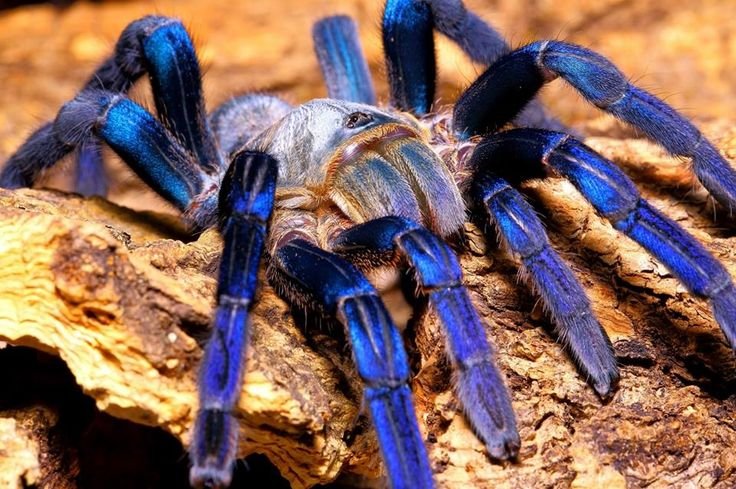The Cobalt Blue Tarantula (Haplopelma lividum), often referred to as the “Cobalt Blue” or “Electric Blue” tarantula, is a captivating and striking arachnid species known for its vibrant blue coloration and fascinating behavior. These tarantulas are native to the dense tropical rainforests of Southeast Asia, particularly in countries like Thailand, Myanmar, and Laos. In recent years, they have gained popularity among exotic pet enthusiasts due to their unique appearance and intriguing characteristics.
Why Choose a Cobalt Blue Tarantula as a Pet?
There are several compelling reasons why individuals opt to bring a Cobalt Blue Tarantula into their homes as a pet:
- Exquisite Aesthetics: The most conspicuous feature of the Cobalt Blue Tarantula is its stunning azure-blue hue, which makes it stand out among other tarantula species. The vivid coloration and their contrasting jet-black legs create a mesmerizing and unforgettable appearance.
- Low Maintenance: Caring for a Cobalt Blue Tarantula is relatively low-maintenance compared to other exotic pets. They require minimal space and can thrive in a well-maintained enclosure, making them an excellent choice for individuals with limited living space.
- Fascinating Behavior: Cobalt Blue Tarantulas exhibit intriguing behaviors that captivate hobbyists and enthusiasts’ attention. They are known for their burrowing tendencies and impressive hunting techniques. Observing their activities can be both educational and entertaining.
- Unique Pet Experience: For those seeking a pet that goes beyond the conventional cats and dogs, owning a Cobalt Blue Tarantula offers a unique and unconventional pet-keeping experience. It allows owners to explore the world of arachnids, gaining insight into their natural behaviors and habitats.
- Conservation Awareness: Keeping a Cobalt Blue Tarantula as a pet can also contribute to conservation efforts. Many tarantula enthusiasts actively preserve the species in its natural habitat, helping raise awareness about the importance of biodiversity and habitat conservation.
Physical Characteristics and Coloration

The Cobalt Blue Tarantula is renowned for its breathtaking and intense blue coloration, which gives it its common name. Here are some key physical characteristics to help you identify and appreciate your pet:
- Striking Blue Color: The Cobalt Blue Tarantula’s body is covered in vibrant shades of blue, ranging from deep cobalt to electric blue, depending on its age and molt cycle. This striking coloration sets it apart from many other tarantula species.
- Black Legs and Abdomen: In contrast to their vivid blue bodies, these tarantulas have jet-black legs and abdomen, creating a visually stunning contrast that adds to their overall appeal.
- Size: Cobalt Blue Tarantulas are generally medium-sized, with adult females reaching around 5 to 6 inches in leg span, while males are slightly smaller, measuring about 4 to 5 inches.
- Robust Build: They have a robust and sturdy build with a relatively stocky appearance compared to other tarantula species.
Selecting and Setting Up the Perfect Enclosure

Providing a suitable enclosure is paramount for the well-being of your Cobalt Blue Tarantula (Haplopelma lividum). In this section, we will guide you through selecting the right tarantula enclosure and creating a comfortable habitat for your pet.
Choosing the Right Tarantula Enclosure
Selecting an appropriate enclosure is the first step in ensuring your Cobalt Blue Tarantula thrives in captivity. Here’s what to consider when choosing the perfect home for your pet:
- Enclosure Size: The size of the enclosure should allow your tarantula enough space to move and burrow comfortably. A 5 to 10-gallon terrarium or similar-sized container is typically suitable for adult Cobalt Blue Tarantulas.
- Ventilation: Adequate ventilation is essential to prevent excess humidity and ensure proper airflow. Most tarantula enclosures have built-in ventilation, but you can modify containers to include small air holes.
- Substrate: Select a substrate that mimics the tarantula’s natural habitat. A mix of peat moss, coconut coir, and vermiculite works well to maintain moisture levels while allowing for burrowing.
- Hiding Spots: Cobalt Blue Tarantulas are shy and appreciate hiding spots. Please provide them with half-buried hides or pieces of cork bark to create secure and secluded areas.
- Accessibility: Consider accessibility for feeding and maintenance. A hinged lid or removable top is a practical choice for accessing your tarantula while minimizing disturbances.
Creating a Comfortable Habitat
Once you’ve selected the right enclosure, creating a habitat resembling the tarantula’s natural environment is crucial. Here’s how to set up the perfect habitat:
- Substrate Depth: Ensure the substrate depth is at least 3 inches to allow for burrowing. Cobalt Blue Tarantulas are avid burrowers and will create tunnels within the substrate.
- Temperature and Humidity: Maintain a temperature range of 75-85°F (24-29°C) and humidity levels around 70-80%. Use a hygrometer and a heat mat if necessary to achieve these conditions.
- Lighting: Cobalt Blue Tarantulas are nocturnal and do not require UV lighting. Ambient room lighting is usually sufficient.
- Water Source: Provide a shallow dish with clean, dechlorinated water for your tarantula to drink. Ensure the container is shallow to prevent drowning.
- Cleaning and Maintenance: Regularly clean and maintain the enclosure by removing uneaten prey items, replacing water, and monitoring temperature and humidity levels. Periodically check for signs of mold or mites.
You’ll provide your Cobalt Blue Tarantula with a safe and comfortable home by selecting the right enclosure and creating a habitat that mimics its natural surroundings.
Caring for Your Cobalt Blue Tarantula

Maintaining the well-being of your Cobalt Blue Tarantula is a rewarding responsibility. This section will cover crucial aspects of tarantula care, including temperature and humidity requirements, lighting, substrate selection, and handling and safety tips.
Temperature and Humidity Requirements
Creating the right environmental conditions is essential for the health and happiness of your Cobalt Blue Tarantula. Here’s how to achieve the ideal temperature and humidity levels:
- Temperature Range: Maintain a temperature range of 75-85°F (24-29°C) in the tarantula’s enclosure. A reliable thermometer monitors and regulates the temperature, ensuring it remains within this range.
- Humidity Levels: Cobalt Blue Tarantulas require higher humidity levels compared to some other tarantula species. Aim for humidity levels around 70-80%. Regularly misting the enclosure or using a humidifier can help achieve and maintain the required humidity.
Lighting and Substrate Selection
Creating a comfortable and natural environment for your tarantula is essential. Here’s what to consider regarding lighting and substrate:
- Lighting: Cobalt Blue Tarantulas are nocturnal and do not require UV lighting. Ambient room lighting or a low-wattage bulb can provide the necessary illumination without disturbing your pet’s natural behavior.
- Substrate: Choose a substrate that promotes burrowing and maintains humidity. A mixture of peat moss, coconut coir, and vermiculite is an excellent choice. Ensure the substrate is at least 3 inches deep to accommodate your tarantula’s burrowing tendencies.
Handling and Safety Tips
While Cobalt Blue Tarantulas are fascinating creatures, handling should be cautiously approached. Here are some important handling and safety tips:
- Limited Handling: Minimize handling as much as possible. These tarantulas are delicate, and excessive handling can stress them out. If handling is necessary, do so with extreme care and only when experienced in tarantula care.
- Defensive Behavior: Be aware of your tarantula’s potential defensive behavior. Feeling threatened, it may raise its front legs and display its fangs. Biting is a last resort, but their venom can be potent, causing discomfort.
- Hand Washing: Always wash your hands thoroughly before and after handling your tarantula to prevent contamination and ensure your pet’s safety.
Feeding Your Cobalt Blue Tarantula

Proper nutrition is crucial to the health and vitality of your Cobalt Blue Tarantula (Haplopelma lividum). This section will delve into the dietary requirements, feeding schedule, and prey options for your tarantula.
Understanding the Diet of a Cobalt Blue Tarantula
Cobalt Blue Tarantulas are carnivorous arachnids that primarily feed on live prey. They are opportunistic hunters in the wild, preying on insects, small arthropods, and occasionally small vertebrates. When kept in captivity, it’s essential to replicate their natural diet as closely as possible.
Feeding Schedule and Prey Options
Maintaining a regular feeding schedule is essential to ensure your tarantula’s health and well-being. Here are some guidelines for feeding your Cobalt Blue Tarantula:
- Frequency: Adult Cobalt Blue Tarantulas typically require feeding once every two to three weeks. Juveniles may eat more frequently, up to once a week.
- Prey Size: Offer appropriately sized prey items. The prey should be approximately the same size as your tarantula’s body or slightly smaller. Suitable prey include crickets, roaches, mealworms, and other small insects.
- Live Prey: Always offer live prey to stimulate your tarantula’s hunting instincts. Ensure the prey is healthy and free from pesticides.
- Monitoring: Observe your tarantula’s behavior during and after feeding. If it does not show interest in the prey or refuses to eat, remove the prey item to prevent stress on your tarantula and potential injury to the prey.
- Avoid Overfeeding: Overfeeding can lead to obesity and health issues in tarantulas. Maintaining a proper feeding schedule and monitoring your pet’s body condition is crucial.
Feeding Techniques
Feeding your Cobalt Blue Tarantula can be an exciting and educational experience. Here are some tips for safe and effective feeding:
- Use Tongs or Tweezers: Use long tongs or tweezers to place the prey item near your tarantula’s burrow or hide to prevent accidental bites. Allow your tarantula to capture the prey itself.
- Patience: Be patient when feeding your tarantula. It may take some time for them to detect and seize the prey. Avoid disturbing them during this process.
- Remove Uneaten Prey: If your tarantula does not eat the prey within a few hours, remove it from the enclosure to prevent stress or injury to your pet.
Feeding your Cobalt Blue Tarantula can be a fascinating aspect of caring for this species. Adhering to a proper feeding schedule and providing the right prey items will help ensure your tarantula remains healthy and content.
Common Health Problems and Solutions
While tarantulas are hardy creatures, they can still encounter health issues. Here are some common problems and solutions:
- Molting Issues
Molting is a natural process for tarantulas, but complications can arise. Ensure a humid environment during molting to aid in the process. Avoid disturbing your tarantula during this vulnerable time.
- Dehydration
Inadequate humidity can lead to dehydration. Ensure a shallow dish of clean, dechlorinated water is available at all times. Mist the enclosure as needed to maintain proper humidity levels.
- Parasites and Mites
Tarantulas can be susceptible to parasites and mites. Regularly inspect your pet for any signs of infestation, such as tiny mites on their body. If detected, consult a veterinarian specializing in exotic pets for treatment options.
- Injury or Stress
Stress or injury can occur due to handling, aggressive encounters, or environmental disturbances. Minimize stress factors and avoid unnecessary handling to prevent injuries.
- Respiratory Infections
Prolonged exposure to damp or cold conditions can lead to respiratory issues. Maintain the appropriate temperature and humidity levels to prevent respiratory infections.
Breeding Cobalt Blue Tarantulas
- Sexual Dimorphism: To breed Cobalt Blue Tarantulas, you’ll need a male and a female. Mature males are typically smaller and have longer, thinner legs than females.
- Introduce the Mating Pair: Introduce the male into the female’s enclosure. Be prepared to supervise the mating process, as the female may become aggressive towards the male.
- Mating Dance: The male will initiate a courtship ritual involving drumming his pedipalps and using silk to signal his intentions. If accepted, the mating process will occur.
- Egg Sac: After a successful mating, the female will create an egg sac. It’s crucial to provide her with a secure and disturbance-free environment.
- Incubation: After laying the egg sac, carefully remove it from the female’s enclosure and place it in an incubator with controlled temperature and humidity. This will ensure the eggs develop properly.
- Hatchlings: When the spiderlings emerge from the eggs, they are highly vulnerable and should be cared for separately in individual containers. Please provide them with appropriate humidity and prey items.
Breeding Cobalt Blue Tarantulas can be challenging, and it’s essential to research and prepare thoroughly before attempting it. Additionally, consider the ethical implications and your ability to care for a potential surplus of spiderlings.
Interacting with Your Tarantula
Interacting with your Cobalt Blue Tarantula can be a unique and educational experience, but doing so responsibly and safely is crucial. Here are some guidelines for observing and bonding with your pet:
Observation:
The primary way to interact with your tarantula is through observation. Spend time watching your pet’s natural behaviors, such as web-building, burrowing, and feeding. This can be a fascinating and educational experience.
Handling:
Handling your Cobalt Blue Tarantula should be limited and done with great care. Only experienced tarantula keepers should attempt handling; even then, it should be infrequent. Follow these safety tips:
- Use gentle and slow movements when approaching your tarantula.
- Always wash your hands before and after handling.
- Handle your tarantula close to the ground to minimize the risk of falls.
- Be prepared for potential defensive behavior, such as rearing up or displaying fangs.
Bonding:
While tarantulas may not form bonds with their owners like mammals do, some keepers report a sense of connection with their pets through observation and gentle handling. Respect your tarantula’s boundaries and focus on providing a comfortable and enriching environment.
Frequently Asked Questions (FAQs)
Are Cobalt Blue Tarantulas suitable for beginners?
Cobalt Blue Tarantulas are not recommended for beginners due to their more challenging care requirements and potential defensive behavior. It’s advisable to gain experience with other tarantula species before considering a Cobalt Blue.
How often should I clean the tarantula enclosure?
Regularly remove uneaten prey items and any waste. Perform a complete enclosure cleaning, including changing the substrate, approximately every 3-6 months, depending on the enclosure’s size.
Can I house multiple Cobalt Blue Tarantulas together?
It is not advisable to house multiple Cobalt Blue Tarantulas together, as they are solitary and highly territorial. Co-habitation can lead to aggression and injury.
Do Cobalt Blue Tarantulas require UV lighting?
No, Cobalt Blue Tarantulas are nocturnal and do not require UV lighting. Ambient room lighting is sufficient.
How long do Cobalt Blue Tarantulas live?
With proper care, Cobalt Blue Tarantulas can live in captivity for 10 to 15 years or more.
Troubleshooting Common Challenges
My tarantula refuses to eat. What should I do?
If your tarantula refuses to eat, it may be in premolt. Avoid offering food during this period, as they will only eat after molting. Monitor for other signs of molting, such as a darkened abdomen and reduced activity.
I suspect my tarantula is sick. What are the signs of illness?
Signs of illness in tarantulas can include lethargy, difficulty moving, abnormal posture, visible injuries, or changes in coloration. If you suspect your tarantula is unwell, consult a veterinarian experienced in exotic pets.
My tarantula is constantly hiding and not coming out. Is this normal?
Yes, it is normal for tarantulas to spend significant time hiding. They are shy creatures, and hiding behavior is a natural part of their daily routine.
How can I prevent mites in my tarantula’s enclosure?
To prevent mite infestations, maintain a clean and dry enclosure, avoid overfeeding, and ensure the prey items you introduce are free from mites.
What should I do if my tarantula escapes from its enclosure?
If your tarantula escapes, remain calm and secure the area. Tarantulas typically stay close to their enclosure. Use a container to capture and return your pet to its enclosure gently.
By addressing common questions and challenges in tarantula care, you can better prepare yourself for a successful and enjoyable experience as a Cobalt Blue Tarantula owner. Continue to educate yourself, seek advice from experienced keepers, and prioritize your pet’s well-being to ensure a fulfilling journey in tarantula ownership.







